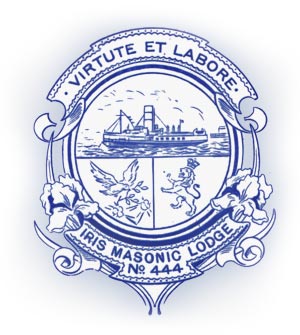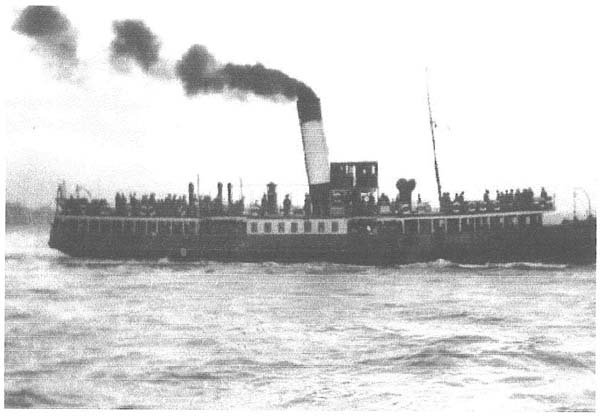|
On the 16th May 1918 Brother A E Young proposed that the Lodge be styled ‘The Iris’ and this was passed. There is no record of why the name Iris was chosen although it is known that the Iris was a ferry boat operating on the Mersey for service between Liverpool and Seacombe, Egremont and New Brighton and takes pride of place on the lodge crest.
|
||||
|
The Iris was built by R Stephenson & Co Ltd at Hebburn-on-Tyne in 1906. She was a triple expansion twin screw vessel with a gross tonnage of 491 and a length of 159 feet. The steamer was built for Ferry Boat service on the Mersey, operating between the port of Liverpool and Seacombe, Egremont and New Brighton on the other side of the river, although she also undertook some excursion work. She was one of two such boats, her sister ship being named Daffodil. On 15 March 1914, their Majesties King George V and Queen Mary came to Wallasey to lay the foundation stone of the Town Hall and it was aboard the Iris that they crossed the Mersey. |
||||
|
|
||||
|
However it was to be for a quite different reason that the craft became famous. Both were ‘called-up’ in the Great War which started in August 1914 and because they both had double hulls and drew only 8’ 6” of water, they could sail over minefields. They were painted grey, armour plating was added, they had HMS prefixed to their names and they were chosen to be used on the first commando raid on Zeebrugge, the Belgian port. They were manned by the Royal Navy. The attack on the harbour was to stop the Germans using Bruges (which was connected to the port by ship canals) as a submarine base. The raid took place on the night of St George’s Day, 23 April 1918. Three old cruisers were filled with concrete so that blasting could not move them and these were to be sunk so as to stop the passageway into the harbour. Along with the “Iris” and “Daffodil”, went the cruiser “HMS Vindictive”, under the command of Commander A.F.B. Carpenter. On the night of the attack they came to the mole and the cruiser let go her anchor, but this did not hold. The Daffodil’s captain was wounded but stayed on the bridge. The cruiser was now in a position to lower the gangways and the landing party raced over. The ferryboat pushed at full speed to hold the Vindictive in position. The daffodil’s boiler room began to flood, due to the holing of the hull. The Iris under the command of Commander Henderson was endeavouring to land marines, but the scaling ladders fell away, so it was decided to land them by way of the cruiser. By the time the Iris had come alongside, the Daffodil sounded the retirement indicating that the operation had been completed. The Iris was told to cast off and head for home with her troops still on board. Meanwhile, the enemy’s guns had opened up and the Iris suffered much damage. The bridge was wrecked on one side and the boat went off course, as men fell like ninepins. A few seconds later, another shell went right through the upper deck and exploded amongst the marines, killing 49 of them and severely wounding a further seven. Four officers and 26 men were killed when another shell hit the sickbay. The Iris steamed on. Lieutenant Spencer, the Navigation Officer, made his way to the wheel. With blood streaming from a wound, he managed to swing the wheel hard over and the Iris turned on course. Another British ship appeared on the scene and came between her and the enemy guns. At last the ferryboat managed to get a smokescreen into action but the Germans still had her in range and further shells found their mark. The ships became world famous after their exploits at Zeebrugge and the King commanded that the Iris and the Daffodil should have the prefix ‘Royal’ added to their names, in recognition of their part in saving the troops. Both vessels re-entered service as ferryboats, after being repaired at Chatham. Later, Admiral Sir David Beatty and Lady Beatty came to Merseyside and sailed on the Royal Daffodil to New Brighton. The boat then berthed next to the Royal Iris. The purpose of the visit was to unveil on the ferryboats, the ‘Zeebrugge bronzes on which were inscribed the names of those men who had died in action in the raid, including Commander Valentine Gibbs RN who commanded the Royal Iris. The Royal Iris was sold in October 1931 to Palmer Brothers for £6000. She was used as a cruise boat operating from Dublin under the same name. She was later used at Cork. In 1947, she was renamed ‘Blarney’, having been purchased by Cork Harbour Authorities. Taken from “Almost an Island – The Story of Wallasey” by Noël Smith. Footnote: The Annual Zeebrugge service takes place on one of the ferryboats on the Sunday nearest to St George’s Day. One may speculate that this may have been why, having been thwarted in their attempt to name the Lodge ‘St George’, the founding fathers chose the name Iris. Since the Lodge had its Warrant issued on 8 October 1918 and was dedicated on 18 February 1919, and the raid took place on 23 April 1918, the boats being awarded the prefix ‘Royal’ shortly after arriving on the Mersey on 17 May 1918, there may be something to be said for the claim that the Lodge should be called Royal Iris!
|
||||

